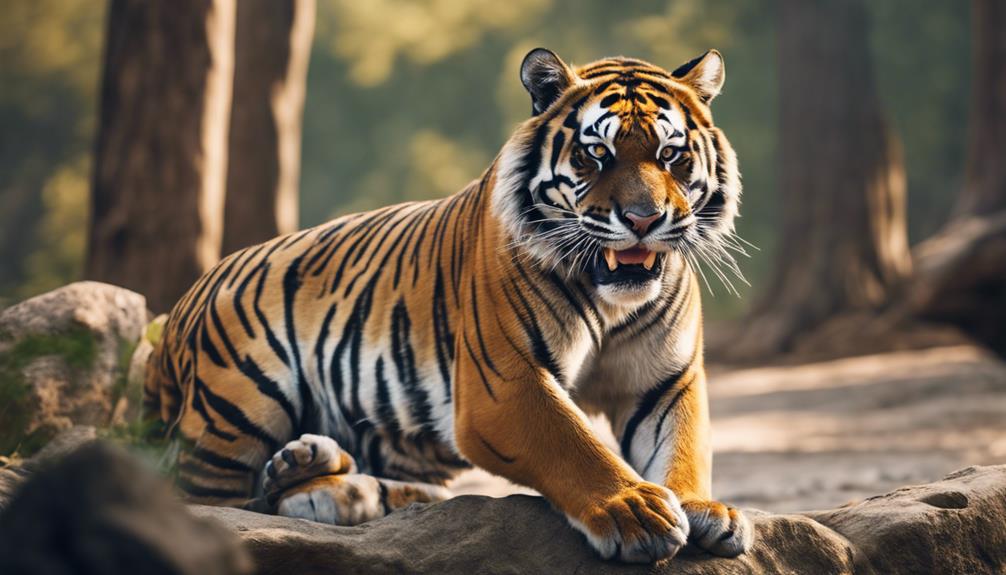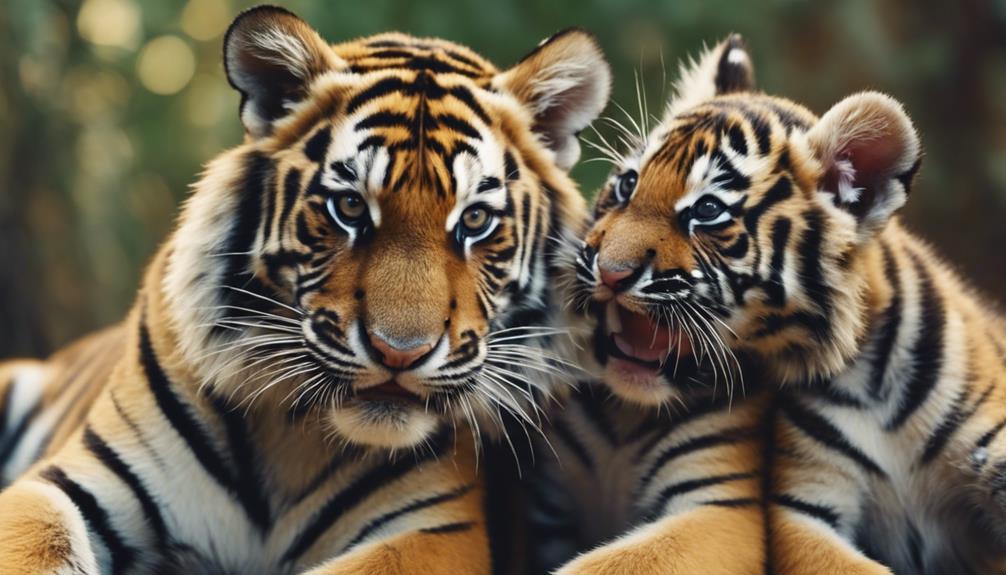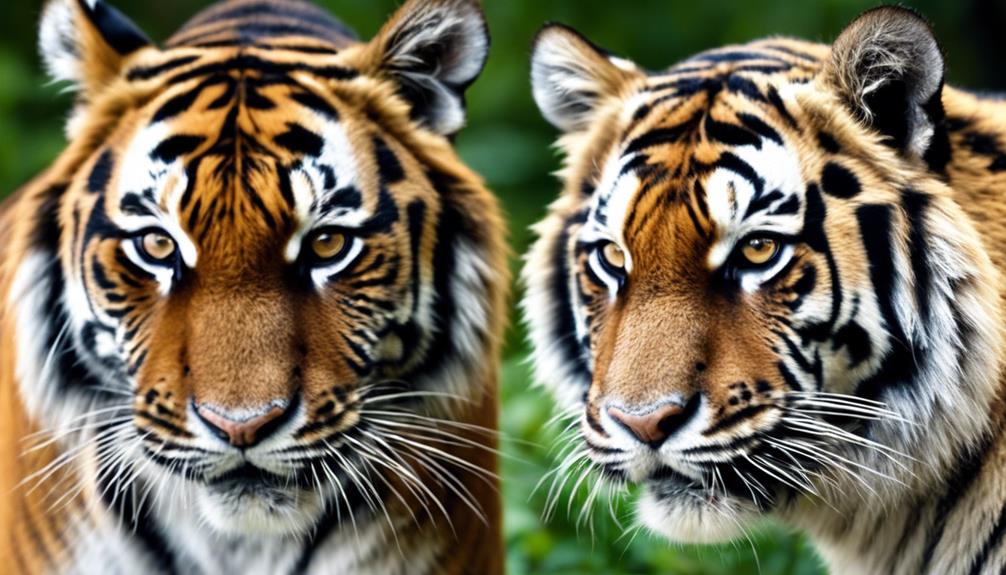Have you ever thought about the intriguing parallels between the majestic female tiger and the enigmatic depths of the wilderness?
In the heart of the dense forest, a silent huntress moves with grace and power, embodying the essence of untamed beauty.
As you consider the name for this fierce feline, a question arises – what is a female tiger called?
The answer may surprise you and shed light on the intricate world of these alluring creatures.
Stay tuned to uncover the mystery behind the title of a female tiger and explore deeper into their mesmerizing domain.
Female Tiger Terminology

When referring to female tigers, they’re commonly known as tigresses. Tigresses are smaller in size compared to males, typically ranging from 6.56 to 9 feet in length and weighing between 300 to 350 pounds.
Their tails are shorter than those of male tigers, and their paws are more shift. Tigresses have muscular bodies covered in orange fur with dark stripes, unique stripe patterns, and distinctive features like beard-like chin fur. Their fur changes from orange to white on the underbelly.
They’ve rounded heads, elongated chin fur resembling a beard, and rounded ears with white spots encircled by black fur. Tigresses also have long canine teeth, lengthy whiskers, and visible teats when pregnant.
Understanding the characteristics specific to female tigers helps in appreciating their unique beauty and strength in the wild.
Physical Characteristics of Female Tigers
Female tigers display unique stripe patterns, with their fur fading into white on the underbelly. They’ve rounded heads, elongated chin fur resembling a beard, and rounded ears with a white spot encircled by black fur. Additionally, female tigers possess long canine teeth, lengthy whiskers, and teats that become visible when pregnant. These physical characteristics not only contribute to their survival in the wild but also add to their majestic appearance as apex predators.
Social Behavior of Female Tigers

Understanding the social behavior of female tigers provides insights into their complex interactions within their ecosystem. Female tigers exhibit pivotal behavior by marking boundaries with urine, feces, or claw marks to establish their domain.
They play a vital role in raising their young from birth until about six months old, training them to hunt and fend for themselves. During estrus, females engage in scent-marking rituals to signal their mating readiness to potential partners.
These behaviors are essential for maintaining the intricate social structures that female tigers rely on for survival, offspring rearing, and successful mating opportunities. By observing the social behavior of female tigers, researchers can gain a deeper understanding of the dynamics within tiger populations and the factors influencing their reproductive success and overall well-being in the wild.
Female Tiger Group Dynamics

Female tigers exhibit dynamic group behaviors that play a significant role in their survival and reproductive success in the wild. These majestic felines are known to form groups called an ambush or a streak. While female tigers are protective of their cubs, these groups aren’t permanent structures.
Young tiger cubs leave the nest at about six months to learn how to survive on their own, facing various risks that challenge their chances of reaching adulthood. With a fifty percent mortality rate for tiger cubs, the wild presents numerous dangers for these vulnerable young felines.
Despite the safeguarding nature of female tigers and their efforts to make certain the survival of their offspring, the harsh realities of the wild pose significant threats. Understanding the dynamics of female tiger groups sheds light on the challenges these magnificent creatures face in their quest for survival and perpetuation of their species.
Conservation Challenges for Female Tigers

In the preservation efforts for female tigers, you face multifaceted challenges that demand immediate attention and strategic interventions.
Female tigers encounter various threats to their existence, including habitat loss due to deforestation and human encroachment. This destruction disrupts their natural territories, leading to increased human-tiger conflicts as these majestic animals struggle to find food and space to thrive.
Additionally, illegal poaching for their body parts, such as fur, claws, and bones, poses a significant danger to female tigers. The demand for these items in black markets drives ruthless hunting practices, further endangering the already vulnerable tiger populations.
Besides, the illicit breeding of tigers for commercial purposes not only jeopardizes the health and genetic diversity of female tigers but also perpetuates the cycle of exploitation.
To safeguard the future of female tigers, concerted efforts in habitat protection, anti-poaching measures, and sustainable conservation practices are critical to address these pressing conservation challenges.
Male Vs. Female Tiger Comparison

When comparing male and female tigers, one noticeable difference is their size and weight. Adult male tigers are generally larger than females, with males growing to about 9 feet in length and weighing around 550 pounds. In contrast, female tigers reach an average length of 8 feet and weigh about 400 pounds. Male tigers are approximately 5-10% larger than their female counterparts, showcasing a significant size disparity between the two genders.
Additionally, male tigers tend to have larger territories compared to females, reflecting their need for more space to roam and hunt due to their larger size. This size contrast extends to their physical features, with male tigers typically exhibiting broader skulls, thicker necks, and bigger paws than female tigers. These distinctions in size and weight play a vital role in defining the characteristics and behaviors of male and female tigers in the wild.

Erzsebet Frey (Eli Frey) is an ecologist and online entrepreneur with a Master of Science in Ecology from the University of Belgrade. Originally from Serbia, she has lived in Sri Lanka since 2017. Eli has worked internationally in countries like Oman, Brazil, Germany, and Sri Lanka. In 2018, she expanded into SEO and blogging, completing courses from UC Davis and Edinburgh. Eli has founded multiple websites focused on biology, ecology, environmental science, sustainable and simple living, and outdoor activities. She enjoys creating nature and simple living videos on YouTube and participates in speleology, diving, and hiking.
🌿 Explore the Wild Side!
Discover eBooks, guides, templates and stylish wildlife-themed T-shirts, notebooks, scrunchies, bandanas, and tote bags. Perfect for nature lovers and wildlife enthusiasts!
Visit My Shop →
